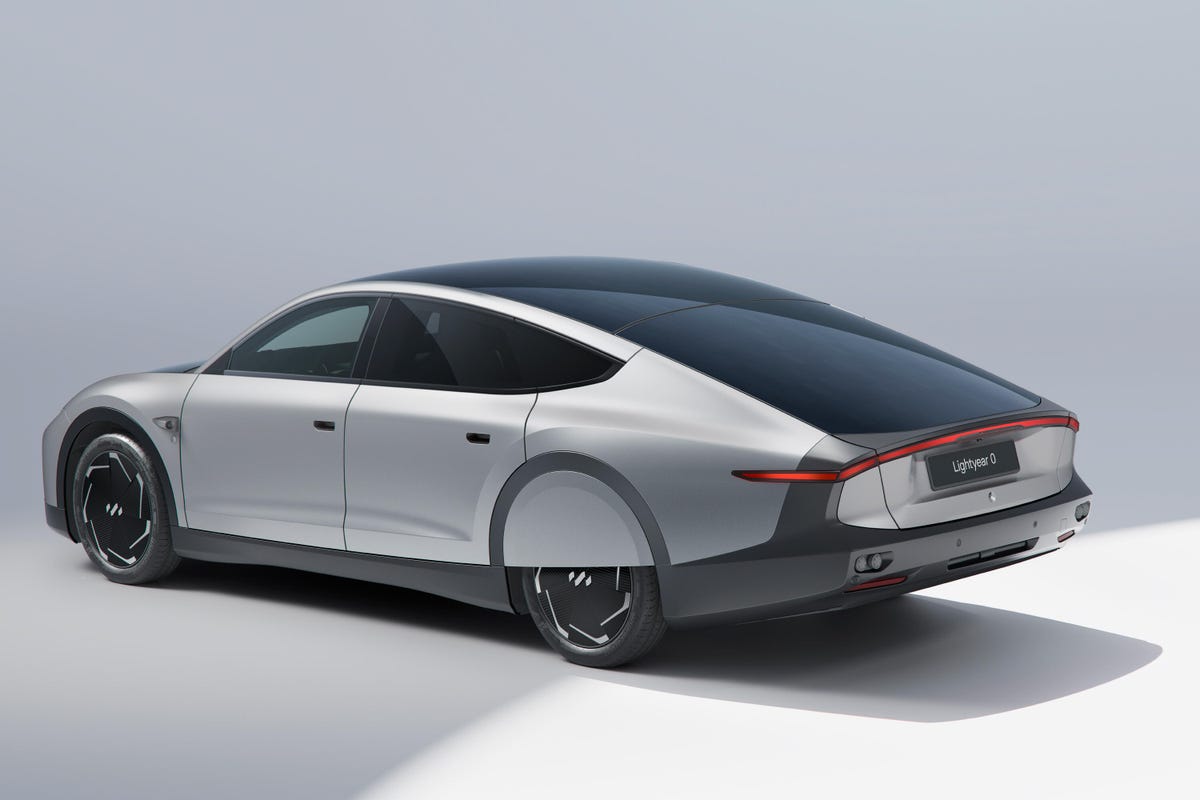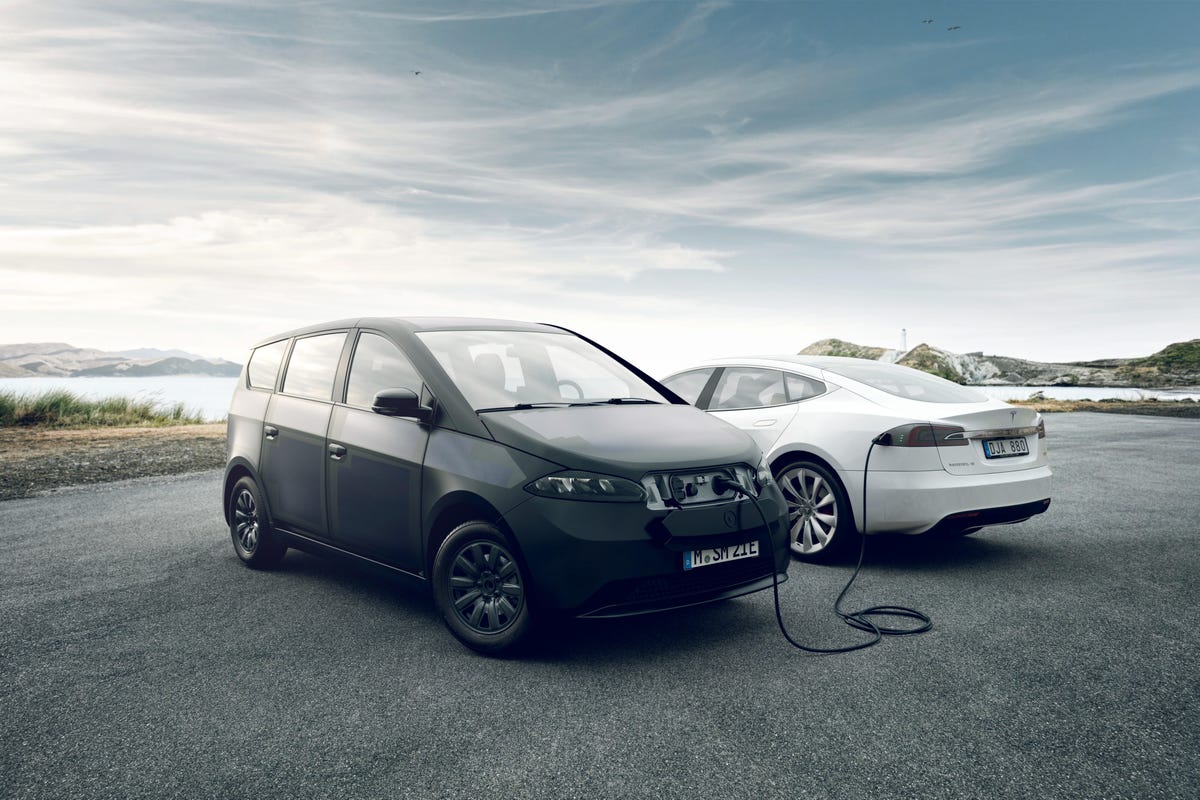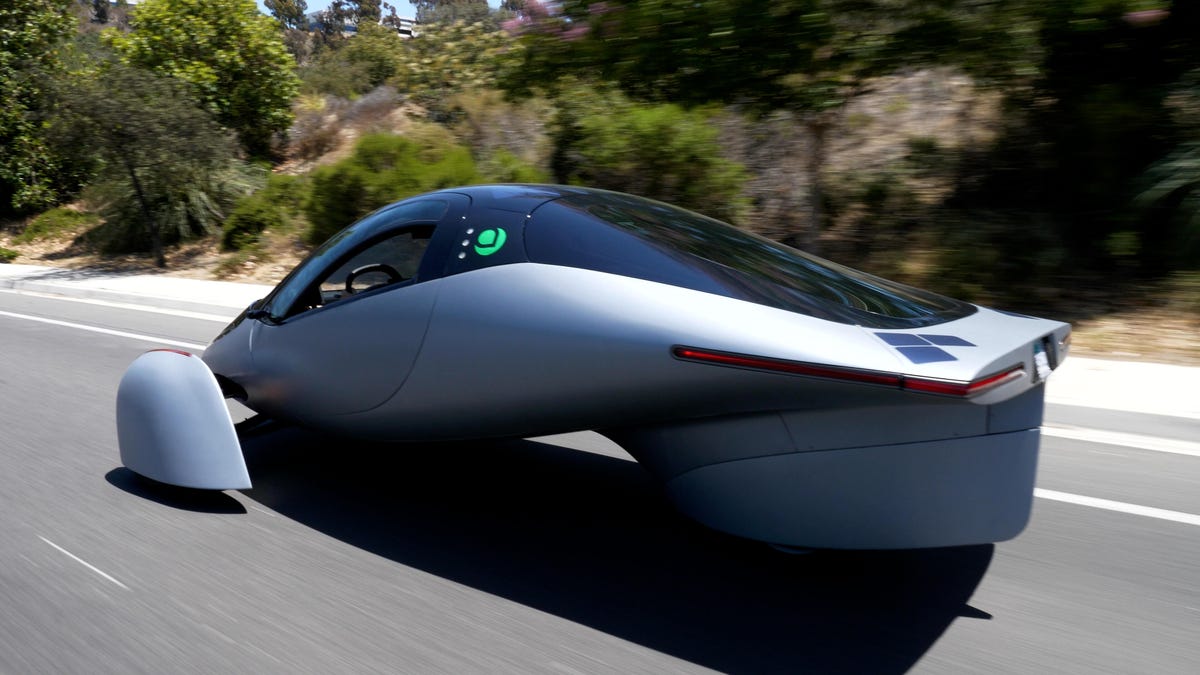
Solar Cars Are Coming, But at What Price — and Are They suitable for You?
This story is part of Plugged In, CNET’s hub for all things EV and the future of electrified mobility. From vehicle reviews to helpful hints and the unexperienced industry news, we’ve got you covered.
A practical solar car has been the stuff of sci-fi, mostly relegated to proofs of concept, but lately that changed as three astounding makers are putting them on the market. Long-range EV buyers who think these cars will let them completely cut the cord are causing to be disappointed, but those who have a realistic view of their driving arranges might be enthused.
All of these early heads still embrace plugged-in charging but layer on solar charging as a splendid line method to cover most ordinary driving. Whether that’s true will loyal on each driver’s mileage needs and access to sunlight; spruce car nuts who love to keep their car garaged or covered need not apply.
Lightyear 0
TheLightyear 0 comes off as the most sophisticated of the early solar cars, and for a quarter of a million bucks, it had better. Don’t worry, the next two cars I show you cost near the same as the sales tax on this one.
Lightyear says the 54 square feet of solar panels across the top of their car can select as much as 45 miles of driving range per day on top of near 390 miles of total battery range (per the European WLTP test cycle, which tends to be optimistic compared to the US ratings). Of that range 320 miles can be garnered in near an hour when plugged into a DC fast charger.

The Lightyear one with optional rear-wheel aero fairings and most of its solar cells on display.
Lightyear
The Lightyear 0 weighs just thought 3,500 pounds, which, by today’s standards, is svelte, especially for a car carrying a heavy battery pack that typically weighs from 500 to 800 pounds. Part of that lightweighting comes from using simple, compact in-wheel motors, which is something of a given in the solar car business.
Only 950 of these cars are slated for initial subjects, with sale limited to the UK and parts of the EU.
Sono Sion
At the new end of the price spectrum lies the Sono Motors Sion at nearby $30,000, an extrapolation since this car is also not slated for the US market. The Sion offers 190 miles of total range and 70 to 150 much per week of solar range, another example of the pretty tortured dual-range estimates solar car companies provide, owing to the two disparate ways their cars get electric energy.

The Sono Sion’s invent is all business and all solar, with almost every inch of its bodywork covered in cells.
Sono Motors
The Sion is plastered in solar panels, not just on the top-facing surfaces and, as a finish, thumbs its nose at styling awards. When you do need to plug in a Sion, a DC fast beak will pack on around 80% of its 190 much range in 30 minutes or so.
Like several non-solar EVs, the Sion boasts of persons able to power other things, like EVs that Sono’s imagery cheekily suggests got stranded deprived of solar.
Sono recently announced it will commission Finnish instruction manufacturer Valmet as its manufacturing partner, placing the Sion in the same attractive that built many years of Boxsters and Caymans, as well as some current Mercedes models. No garage band there.
Aptera
If the Aptera vehicle looks odd, it’s because it’s been knocking around as the next big sketch for at least 15 years. Now in solar electric form, it warrants (yet) new look. You’ll either love or laugh at its airplane-without-wings styling and survey that it’s a three-wheeler. But Aptera says all that helps it barge over the air using as little as 30% of the energy of an EV or Hybrid.

The Aptera solar electric vehicle is radically different from any car.
CNET
Its unconventional, light and slippery design creates a virtuous circle: The vehicle devises a smaller, lighter battery pack that, in turn, augments the vehicle’s lightness, allowing for a meaningful state of charge to be created via the sun. Aptera uses an interactive mapping tool to illustrate how much solar driving you noteworthy expect. On top of that, you can configure an Aptera with battery options preparing from 250 to an almost incredible 1,000 miles.
The vehicle holds two country, and it helps if they’re good friends: The pontoon fender bracketed cabin is snug (at least it’s not a tandem) thought it has a substantial rear storage deck reminiscent of a Jaguar E-Type.
Notice I have been referring to the Aptera as a vehicle, not a car, because that’s a key distinction. In the humorless eyes of your local DMV clerk, the Aptera is a motorcycle, or perhaps an “auto-cycle.” You’d need to check the motor vehicle laws in your state, but you should at least not need a helmet as the sketch is fully enclosed. You might, however, need a motorcycle or three-wheel vehicle endorsement. And note that, as a non-car, the Aptera does not have to conform to the same security standards as cars, like having airbags.
Of the three cars I’ve shown you, this is the only one made and sold in the USA, preparing from about $26,000 for 250 miles of range to nearby $50,000 for one with an astounding projected 1,000 much. In a way, the Aptera makes the most felt because it’s so utterly distinct from any other EV that it fights for being owned along with one.
Normalizing or niche?
While you make up your mind nearby solar cars, here’s what I think: Real-world performance feedback is moving to be very important, as this is a new kind of charging that almost no driver has any known with.
That said, untethered charging does something potent: It grants an EV to potentially leapfrog the convenience of a gas-engined car pretty than just trying to approximate it. That’s right in line with my thought that the best charge isn’t the fastest but the most persistent and transparent.
I suspect that EV intenders are moving to be pretty skeptical of solar cars, or they noteworthy break the opposite way and accept the concept, thanks to millions of dignified solar installations in the US that have set the execrable for the technology.
Solar cars are an interesting proposition for the prepper who realizes that, as almost everything is repositioning electric, almost nothing will work when the grid is down. It would be nice to know that, even when that happens, you still have a working car.
Finally, I have my affects about the limited solar range these cars deliver at a time when we are throughout to see massive growth in conventional charging infrastructure; That would seem to get a risk that the solar proposition gets lost in a sea of extinct charging that could relegate solar vehicles to just the most serious environmentalists or technology dilettantes.
All that said, there is an undeniable elegance to a solar electric car, so I’ll be watching them for you.
Solar Cars Are Coming, But at What Price -- and Are They Right for You?. There are any Solar Cars Are Coming, But at What Price -- and Are They Right for You? in here.
About Me
Total Pageviews
Search This Blog
Blog Archive
-
-
-
-
-
- Samsung Neo QLED TVs promise prettier pictures, be...
- Amazon Prime Price Hike: There's Still Time to Loc...
- The difference between Oppo's flashy, new foldable...
- Tesla is 'irresponsible' for touting 'Full Self-Dr...
- Custom Snapchat Stories let you collaborate with f...
- Withings ScanWatch Horizon Review: Luxury Looks an...
- 8K TV Explained, and Why You Definitely Don't Need...
- Samsung Q60B TV Review: Slim, Stylish and Surprisi...
- Samsung's next update will make your Galaxy phone ...
- The race to build AR glasses is heating up, and Sa...
- 2023 Subaru Impreza Gets a $1,000 Price Bump
- Samsung Rumored to Launch Another Foldable Phone T...
- Tesla exceeded revenue estimates in Q4 2021 by mor...
- Fitness trackers are getting more personal, powerf...
- Samsung warns phone, TV sales will 'decline signif...
- Best Samsung Galaxy A53 5G Case for 2022
- Netflix Is Open to a Lower Price Tier -- With Ads
- Samsung Unveils Beautiful Poke Ball Galaxy Buds 2 ...
- Tesla CEO Elon Musk Says He Has COVID Again
- Snapchat filters for funerals? Yes, that's really ...
- The New Apple Watch Features, Improvements I Want ...
- Samsung's 65-inch The Frame 4K TV gets a huge pric...
- Samsung replaces all 3 CEOs, merges units in manag...
- Gamevice for iPad Review: A Better Idea Than You'd...
- Samsung Galaxy Z Fold 3 durability: Did the phone ...
- Cheaper Gas: Quick Tips to Save Money at the Pump
- Samsung's S22 Ultra kicks the Galaxy Note to the curb
- Elon Musk sells another $687 million in Tesla stock
- Garmin's Prime Day Smartwatch Deals: Get a Top-of-...
- July 4 best TV deals: Save big on models from LG, ...
- Samsung to bring Galaxy smartphone repair service ...
- The Galaxy S21 lineup is here, with a $200 price c...
- Disney Hints (Again) a Disney Plus Price Hike May ...
- Galaxy Watch 5: All the Notable Rumors Ahead of Sa...
- Elon Musk Doesn't Have to Keep Quiet About Tesla S...
- Snap finally releases a how to use Snapchat video
- Samsung Smartwatch Sale: Save Hundreds on Factory ...
- I visited Samsung's Galaxy S22 metaverse event, bu...
- Samsung Introduces Pokemon-Themed Galaxy Z Flip 3 ...
- 'All the Old Knives' Review: Lacklustre Chris Pine...
- Samsung Galaxy S II (U.S. Cellular) review: Samsun...
- Bose Says Its New QuietComfort Earbuds 2 Have the ...
- Foldable Phone Market Will Hit $29 Billion in 2025...
- Elon Musk Gave $5.7 Billion of Tesla Shares to Cha...
- Save Up to 33% on Nearly All of Amazfit's Great Fi...
- Get rid of annoying TV glare with these 5 tricks
- Samsung Unveils Beautiful Poke Ball Galaxy Buds 2 ...
- Galaxy Note 20: Here's who should buy it and who s...
- Solar Cars Are Coming, But at What Price -- and Ar...
- Your smartphone makes you stupid, study shows
- Why the Galaxy S22 is so important to our freedom ...
- Tesla Gigafactory Berlin Is Almost Allowed to Buil...
- 11 things every Snapchat Spectacles owner should know
- Garmin Lily review: One of the best smartwatches d...
- Disable this feature to stop your Samsung Smart TV...
- Samsung Launches Galaxy S21 Cases Made From Biodeg...
- Withings ScanWatch Horizon Review: Luxury Looks an...
- Galaxy S20 FE vs. other S20 phones: Here's why the...
- Bitcoin Price Roller-Coasters Over and Below $20,000
- Motorola signs up for medium range wireless smartp...
- A Healthy Relationship With Social Media Is Hard t...
- Tesla switches all standard-range vehicles to LiFe...
- Best Fitbits to Buy Right Now
- TV Shopping? Consider buying a 2021 TV (and Save M...
- Samsung Galaxy Buds 2 Are Only $55 for Refurb Mode...
- Samsung confirms no new Note at Unpacked, but will...
- Twitter Blue Subscription Service Is About to Get ...
- Galaxy S20 is the latest smartphone to use an eSIM...
- Samsung Galaxy Z Flip adds 5G, arrives Aug. 7 for ...
- Tesla's prototype battery with 5 times more energy...
- Facebook Messenger testing Snapchat-style 'streaks...
- OnePlus Watch review: It would be hard to recommen...
- Last Day to Save Big On Appliances, Tech and More ...
- Samsung, Starbucks Collab on Coffee-Inspired Galax...
- Asus ROG Flow Z13 Review: Spare the Expense
- Samsung Galaxy Z Fold 4 Design and Camera Details ...
- Xenoblade Chronicles 3 DLC Guide: Expansion Pass P...
- Take this dual-SIM Nokia 8.3 5G Android smartphone...
- Galaxy Z Flip: Everything we do and don't know abo...
- Elon Musk unveils Tesla Bot, a humanoid robot that...
- 9 Great Reads From CNET This Week: 'Infinite' VR, ...
- 4K and 8K TV refresh rates from 60hz to 120Hz: Eve...
- MWC 2022: How to Watch the Samsung Galaxy Book Reveal
- Xbox Games Arrive On Samsung TVs in Cloud Gaming Push
- What to Know About Hidden Fees That Increase the P...
- How to buy a smartphone as a gift
- Samsung slashes Galaxy Z Flip 5G price by $250 to ...
- Tesla Full Self-Driving has an 'Assertive' mode th...
- Rihanna slams Snapchat over controversial ad: 'Sha...
- Shop Amazing Deals on Dozens of Amazfit Smartwatches
- Samsung The Premiere is a 130-inch 4K TV powered b...
- Galaxy S22 Deals: Up to $1,000 Off at Best Buy, $9...
- Review: Wyze Night Lights are as basic as it gets ...
- Galaxy S21 vs. Pixel 5: Which Android phone should...
- OnePlus 10 Pro's Price Drops to $799, Bringing It ...
- T-Mobile adds new Magenta Max plan with no smartph...
- Galaxy Z Fold 2: All the ways this foldable do-ove...
- Tesla Wants to Use Powerwall Battery Systems in Te...
- Best Smartwatch for 2022
- Best OLED TV Deals: Save $903 Off 65-inch C1, $503...
-
-
-
-
-
-
-
